Souleymane Badolo at St. Mark’s Church and David Parker’s The Bang Group at Joe’s Pub brighten a blustery weekend.
How often do Valentine’s Day and President’s Day share the same long weekend? And how often do you venture out to see dancing in a city so snowy that Central Park evokes Valley Forge, and then discover upon leaving the performance that rain is pouring down and the street you have to cross has become a little Delaware? Better perhaps to have stayed home, eaten chocolates with your best beloved, and watched the Olympians do beautiful and sometimes very strange things on ice and snow.
Entering St. Mark’s Church on February 13th to see Danspace Project’s presentation of Souleymane Badolo’s Benon is indeed like entering another world, or—wait!— is it? “Benon” means harvest in one of the languages spoken in Badolo’s West African birthplace, Burkina Faso (I’m guessing it’s hot and dry there tonight). However, a very large see-through bin crammed with plastic water bottles sits in one corner of the church, and another hangs tilted opposite it; lights within these makes them glow ominously yet alluringly. Some harvest! In another corner stands a black door-shaped frame irregularly criss-crossed by dark slats (set by Tony Turner). Entering slowly in semi-darkness, Badolo strews his terrain with plastic glasses. When lighting designer Carol Mullins turns blue beams on them, they glitter like ice, like diamonds.
Two themes can be discerned in this somewhat mystifying piece: rituals unfamiliar to some of us that honor the earth and growing things, and an-too-familiar crisis: pollution of the environment. Badolo, who has lived and worked in New York since 2009, wants to link them.
Benon moves slowly, giving the spectators who are seated on four sides of the church plenty of time to ponder what we’re seeing, and maybe to zone out occasionally—the latter state induced by a combination of the work’s leisurely pace and the fatigue of getting across town.
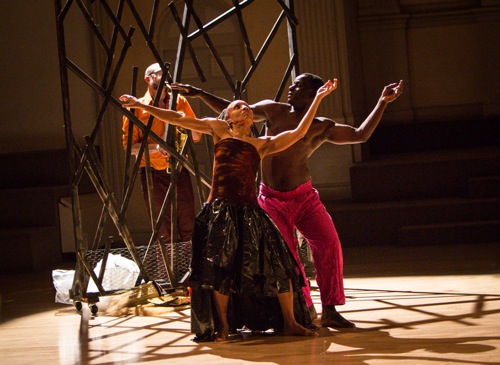
Charmaine Warren and Souleymane Badolo in Benon. Behind them: Jeff Hudgins plays his sax.
Photo: Yi-Chun Wu
Badolo is not the only performer. Pressed close behind him, stepping when he steps, is a smaller person, wearing a skirt constructed of black plastic trash bags, overlaid with a billowing hooded coat made of clear ones (costumes by Omotayo Wunmi Olaiya). Who is this female creature? Do we credit her with creative recycling, or fear her as Queen of Trash? I tend toward the latter. When she finally reveals herself to be Charmaine Warren, a charismatic performer, she seems to fascinate, taunt, and lure Badolo. He sets the scattered glasses on end; she knocks them away. They struggle quite violently, his hand covering her face. Divested of her coat, however, she assumes a different kind of life.
Alone onstage, Warren crouches and slithers along the floor, her eyes searching in various directions. The music, which has consisted of intermittent windy tones, acquires plucked, metallic sounds (somewhat like those of a thumb piano), percussion, voices. Gradually she rises like a plant seeking the light; her shoulders circle, her spine undulates, her hands ripple. When she steps out on one foot and raises her other knee high, she seems to grow several inches. Mullins gives her a circle of light, warms her with a dawn glow. You forget that that this empowered woman’s skirt is a cut-up garbage bag.
When Badolo enters again, he’s wearing an extraordinary kind of back-plate made of grasses (sculpted by him, Jon Isherwood, and Richard MacPike) with more grasses standing up along the sleeves of his red shirt. Now it’s his turn to dance with complicated, oiled movements that pass like thoughts through his body and limbs. Warren becomes more of a helper—laying out plates, posing him, removing the masking grasses so that he can move more freely. Jeff Hudgins, who has been improvising—sparsely and intermittently— on his saxophone becomes more prominent, and when Badolo and Warren begin some big, open dancing in unison, he walks into their duet, and they all rejoice.
What has happened? Has pollution been sent packing? Not likely. But the earth is still producing, and two terrific performers have danced for us.
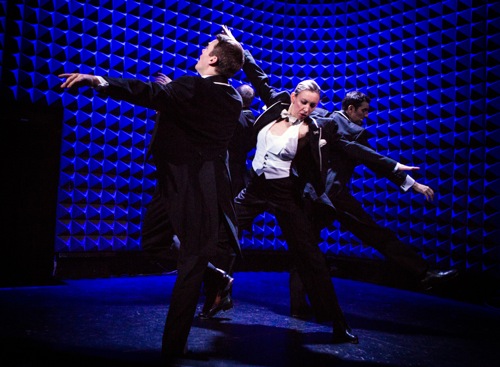
L to R, foreground): Nic Petry and Amber Sloan; at back: David Parker (hidden) and Jeffrey Kazin in Parker’s Head Over Heels. Photo: Yi-Chun Wu
The next night, February 14th, you need ingenuity and width of stride to get across the pools surrounding blocked storm drains. But when Joe’s Pub opens its doors a little after 6 P.M., the place fills steadily. How could you resist a Dancemopolitan commission called Head Over Heels on a day that celebrates romance? The Bang Group (choreographer David Parker, Jeffrey Kazin, Nic Petry, and Amber Sloan) has taken on the challenges, perils, and pleasures of love. In this wryly charming cabaret show, the performers sing, tap dance, and tangle to a medley of tunes, old and new. All this, of course, on Joe’s Pub’s pocket-sized stage (cleverly lit by Lauren Parrish), while very discreet waitpeople slip around delivering food and drink.
The titles of the show’s ten sections all begin with “re,” as in “Restlessness,” “Reconciliation,” and “Recrimination.” There’s more than a hint of irony, ruefulness, and resignation in some of the music Parker has chosen, such as Frank Loesser’s “Never Will I Marry” from Greenwillow and the defiant “Fifty Percent” (music by Billy Goldenberg) whose lyrics (by Alan and Marilyn Bergman) announce that getting half of what you want from someone you love and who loves you is still a hell of a lot. Jeff Blumenkrantz’s “Moving Right Along” takes a sardonic look at the search for the right partner (for the night, for life). Petry, Kazin, and Parker stroll about an imaginary gay bar, eyeing now this guy, now that one, as they argue about relative merits (“too peppy, too preppy, too Johnny Deppy. . .”).
Wearing tap shoes, black trousers, white shirts and vests, black ties, and black tailcoats whose lapels are edged in white (costumes by Pei-Chi Su), the four slip expertly on and off the stage, adjusting their attire for less formal moments. I didn’t remember that all these performers were such adroit tappers or that all three men could put over a song so expertly. In “Reconsideration,” Kazin, his black tie undone, sings the Burt Bachrach-Hal David “Wanting Things” and Bob Merrill’s “Her Face” from Carnival (switching the references to “his face”), while Parker serves as stool for him to sit on and slips to the floor between his legs to become a minor obstacle. Yet Kazin, without missing a note or an inflection, helps Parker to his feet when necessary and caresses his head in passing. The two end standing, nestled together, holding hands, and rocking as if on a single front-porch chair. It’s a lovely way of visualizing lyrics that tell how someone you never noticed much has become a vibrant presence.
Body rhythms become a way of conversing in “Reconciliation.” Sloan and Petry employ clapping, slapping, and barefoot stamping on a mic’d floor to exchange questions, display affection, and yield to anger (their “score” was inspired by Steve Reich’s Clapping Music). This number seems a bit long, but the combination of shifting emotions and smart percussion is a treat.
As a witty little nod to ballet elegance and absurdity, Kazin and Parker sing Giacomo Rossini’s Duetto Buffo di Due Gatti. Rubbing and butting up against each other, they whip through lyrics that consist of these Italian cats’many iterations and virtuosic embellishments of “Miau!” Sloan and Petry arrive when the music changes to Tchaikovsky’s playful music for “Puss and Boots” from The Sleeping Beauty.
The evening ends with another Reich-inspired number, “Restoration.” This time all four winning performers tap complex counterpoint in a huddle that keeps winding into different tight formations; occasionally they kiss hands or lips in passing. Not always tidy, but crisp and fresh. As in long-term love, timing and cooperation are crucial, and surprises continue to lurk.

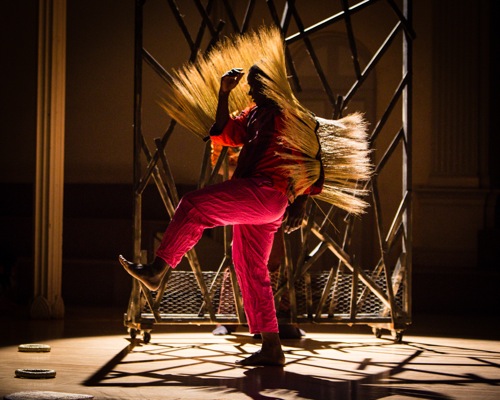
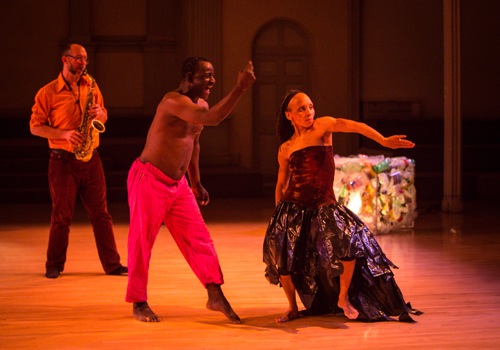
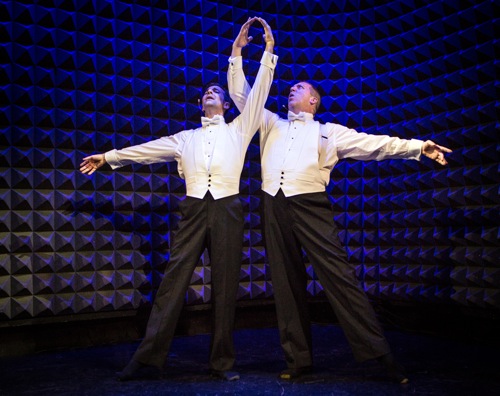
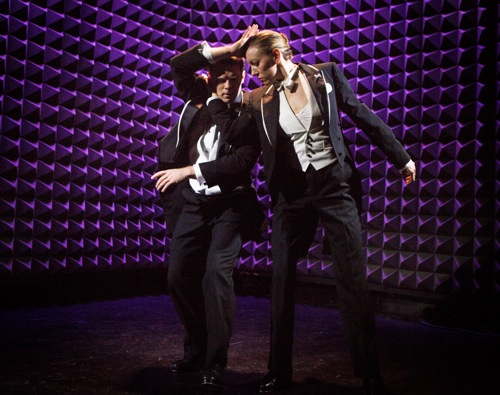
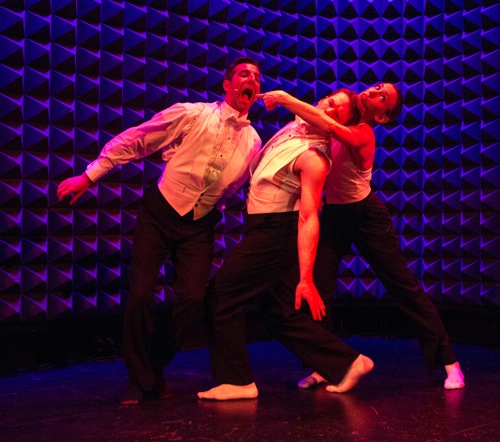
As always, Deborah Jowitt hits the nail on the head. (I can see her twist her lips a little in reproach for using a cliche in my writing…but sorry it fits). I was at this same show and concur with her enthusiasm 100%, I am ever so amazed at how she sees and remembers more than a human being should be capable of and of course she describes those moments with absolute poetic eloquence.
Thanks to Deborah for seeing so much and saying it so well. I know that dance reviews are really meant more for the public than for the artists involved but I always read Deborah’s reviews for insights that I can use artistically. In this case, I actually shortened the dance she found a bit too long (I concurred) and it’s better. It is terribly rare that a critic can speak equally to audiences and the artists who created the work under review. I’m so glad this forum exists.